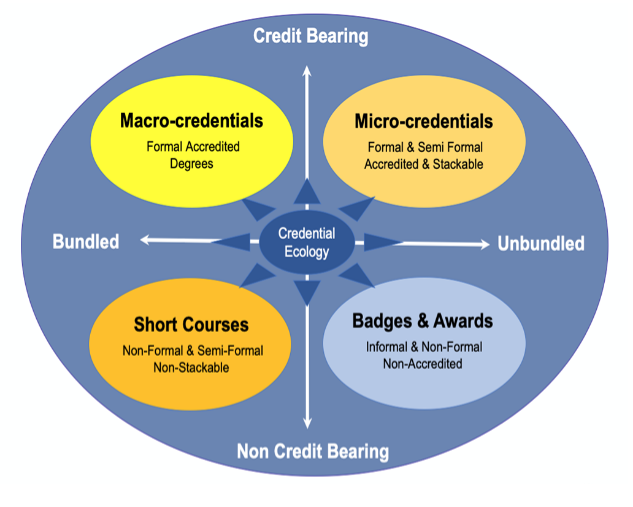MICRO-CREDENTIALS, THE NEXT CHAPTER IN HIGHER EDUCATION
Reference: GS 2 – Education
Why in the News?
There exists a disparity between the knowledge acquired by students in Higher Education Institutes (HEIs) and the skills required for employability.
- HEIs should take on a more proactive role in bridging this gap by facilitating connections between students and future career opportunities.
About Micro-credentials
- Micro-credentials offer a disruptive solution to bridge the knowledge gap by providing just-in-time acquisition of modern skills and competencies.
- Micro-credentials are concise learning activities with validated learning outcomes, often obtained through a standardized assessment process.
Features of Micro-credentials
- With their flexibility, accessibility, and tailored advantages, micro-credentials are becoming the new norm in higher education.
- Flexibility: Offered in online, physical, or hybrid formats, micro-credentials cater to diverse learning preferences and schedules.
- Accessibility: Available at various levels (beginning, intermediate, advanced), micro-credentials enable learners to acquire targeted skills efficiently.
- Target Audience: Designed not only for traditional students but also for working professionals seeking continuous learning opportunities.
Providers of Micro-credentials:
- Diverse Players: A range of organizations, including Atingi, Alison.com, Credly, Coursera, edX, FutureLearn, Google, LinkedIn, Microsoft, PwC, and Udacity, offer micro-credentials.
- University Engagement: Many universities across Australia, Canada, Europe, the United Kingdom, and the United States are actively involved in providing micro-credentials, showcasing the widespread adoption of this learning model.
Credit System Comparison
| Conventional Higher Education | Micro-credential Approach |
| Formal degree programs utilize ‘credits’ to quantify various learning activities such as lectures, tutorials, laboratory work, seminars, projects, and internships. Typically, courses are structured to be three to four credits, with one credit equating to one hour of lecture or two hours of lab work per week. | In contrast, micro-credentials associate credits with the notional hours required to acquire a defined minimum competency. This alignment with conventional higher education credits ensures consistency and facilitates universal validation and recognition. |
Quality Benchmarking and Regulation:
- Necessity: Clear quality benchmarking and regulation are imperative to prevent significant disparities in learning outcomes and to facilitate widespread endorsement of micro-credentials in both workplace and higher education settings.
- India’s National Credit Framework (NCF): India has implemented the National Credit Framework (NCF), outlining learning outcomes and corresponding credits necessary for student progression to higher levels of learning. This framework aims to standardize the evaluation and recognition of micro-credentials.
Benefits of Micro-credentials
- Provide just-in-time learning, ideal for acquiring modern skills and competencies, particularly relevant in a rapidly evolving job market.
- Portability and Stackability: Micro-credentials offer the advantage of being portable and stackable, meaning they can be accumulated and displayed on digital platforms such as the Academic Bank of Credits (ABC). This facilitates lifelong learning and skill development.
- Contrary to macro-credentials like undergraduate degrees that require years of study, micro-credentials offer quicker pathways to skill acquisition.
- Shift in Hiring Practices: Employers increasingly prioritize skills over degrees, driving the endorsement of micro-credentials as indicators of specific competencies.
- Adaptability: Micro-credentials align with the evolving landscape of higher education and meet the needs of learners seeking flexible, tailored learning experiences.
- Validation: Standardized assessment processes ensure the reliability and credibility of micro-credentials, enhancing their recognition and value in the job market.
- Lifelong Learning: Particularly beneficial for working professionals who may not have the time or resources to pursue formal degree programs but seek to upskill or reskill throughout their careers.
Alignment with Higher Education Standards
Micro-credentials should adhere to higher education standards in terms of delivery methods and assessment practices to ensure genuine skill acquisition.
- Grading and Qualifications: Reliable grading systems must be implemented, and qualifications awarded should reflect the skills acquired through micro-credentials.
- Role of HEIs: The involvement of Higher Education Institutions (HEIs) is crucial in developing trustworthy assessment methods, fostering trust in micro-credentials.
- Opportunities for Students: Micro-credentials offer Indian university students opportunities to integrate diverse skills into their regular education.
- Credit Accumulation: Students can store credits on the Academic Bank of Credits (ABC) for later redemption or for obtaining separate certificates or diplomas alongside their macro-credentials.
- Credit Allocation: Micro-credentials can range from one to five credit short modules, allowing learners to accumulate credits towards obtaining degrees as specified in the National Credit Framework (NCrF).
Potential and Implementation:
- Opportunity with NCrF: With the implementation of the National Credit Framework (NCrF) across India, HEIs should collaborate with industries to develop micro-credentials.
- Strategic Planning: HEIs should consider integrating credit-based micro-credentials into regular degree programs, aligning with strategic institutional objectives.
- Demand and NEP 2020: With the National Education Policy 2020 emphasizing skill-based education and employers seeking skilled employees, there is increasing demand for micro-credentials among learners.
- Agent of Transformation: Indian HEIs must embrace micro-credentials as a vital component of their transformation agenda, catering to the evolving needs of learners and industries.
- Harmonization and Validation: Regulators and HEIs should collaborate to harmonize micro-credentials with existing academic programs, establishing clear validation metrics to ensure their credibility and integration into the tertiary education system.
Mains question
Discuss the role of micro-credentials in Indian higher education addressing alignment with standards and integration into university programs, and potential impact on skill development. (250 words)




